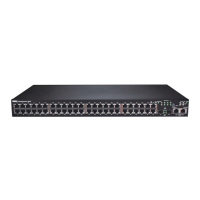RPM Ports and Cables | 39
8
RPM Ports and Cables
The RPM contains three ports, which are labeled and described as:
• Console. A Universal Asynchronous Receiver/Transmitter (UART) port with an RJ-45 jack is used for
system configuration and monitoring. Modem connections are not supported on the Console.
• Auxiliary. A UART port with an RJ-45 port allows modem access to the E300 system from a remote
location.
• 10/100 Ethernet. A 10/100 Ethernet port is the Management port, which is a channel to download
images and manage the system, as well as FTP and Telnet operations. You must provide a RJ-45
Ethernet cable to connect to the Ethernet receptacle.
Connecting the Console and Auxiliary Ports
NOTE: Attach an ESD-preventive wrist strap and connect the leash to the ESD connection on the front of the
E300 chassis. Always wear an ESD-preventive wrist or foot-heel ground strap when handling components.
The console and auxiliary ports are asynchronous serial ports. If you connect a device to these ports, it
must be capable of asynchronous transmission. Your terminal or terminal emulation mode must be set to
VT100 with the following settings:
• 9600 baud rate (to avoid autobaud input, the default is set to a 9600 bps baud rate)
• No parity
• 8 data bits
• 1 stop bit
• Window Terminal Emulator option set to NO
• 24 lines X 80 characters
• No flow control (console port only)
• Hardware flow control (RTS/CTS) (for auxiliary port only)
Cable and Adapter Pin Assignments
Use the E300 System Console port on the RPM to connect to a terminal port, PC serial port, or a terminal
server to configure and monitor your system. Use the E300 Auxiliary port on the RPM to connect to a
modem.
Both the Console and Auxiliary port are RJ-45 ports.
Figure 8-1
displays the pinouts in an RJ-45 port.

